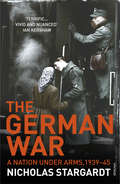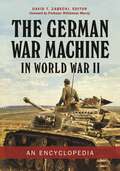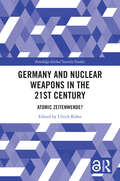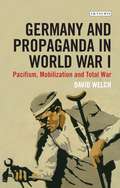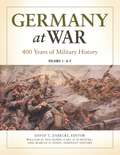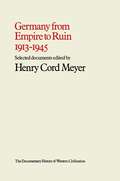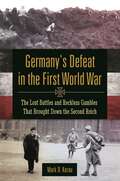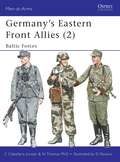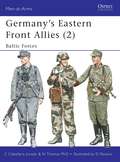- Table View
- List View
German Troops in the American Revolution: Hessen-Cassel (Men-at-Arms)
by Donald M. Londahl-SmidtDuring the American Revolution (1775–83), German auxiliary troops provided a vital element of the British war effort. Some 30,000 German troops served in North America, continuing a long-established relationship between Britain and various German principalities. These troops were widely referred to as mercenaries, implying that they sold their services individually, but they were in fact regular troops hired as a body by the British. Initially feared by the American population, the German troops came to be highly respected by their opponents. Their role in the fighting would inform the tactics and methods of a generation of German officers who returned to Europe after the war, many of whom went on to hold senior commands during the French Revolutionary and Napoleonic wars. The largest body of German troops was from Hessen-Cassel. The only German contingent to be employed as a unit under its own general officers, they were clothed and equipped in the style of Frederick the Great's Prussians and were trained in much the same way. Many had seen active service during the Seven Years' War (1756–63) and served under career officers; they were well-disciplined and competent but showed little overt enthusiasm for the British cause. The troops of Hessen-Cassel would participate in every major campaign of the conflict, with the specialized skills of the famous Jäger being particularly in demand. Fully illustrated, this lively study examines the organization, appearance, weapons, and equipment of the Hessen-Cassel troops who fought for King George in the American Revolution.
German Troops in the American Revolution: Hessen-Cassel (Men-at-Arms #535)
by Donald M. Londahl-SmidtDuring the American Revolution (1775–83), German auxiliary troops provided a vital element of the British war effort. Some 30,000 German troops served in North America, continuing a long-established relationship between Britain and various German principalities. These troops were widely referred to as mercenaries, implying that they sold their services individually, but they were in fact regular troops hired as a body by the British. Initially feared by the American population, the German troops came to be highly respected by their opponents. Their role in the fighting would inform the tactics and methods of a generation of German officers who returned to Europe after the war, many of whom went on to hold senior commands during the French Revolutionary and Napoleonic wars. The largest body of German troops was from Hessen-Cassel. The only German contingent to be employed as a unit under its own general officers, they were clothed and equipped in the style of Frederick the Great's Prussians and were trained in much the same way. Many had seen active service during the Seven Years' War (1756–63) and served under career officers; they were well-disciplined and competent but showed little overt enthusiasm for the British cause. The troops of Hessen-Cassel would participate in every major campaign of the conflict, with the specialized skills of the famous Jäger being particularly in demand. Fully illustrated, this lively study examines the organization, appearance, weapons, and equipment of the Hessen-Cassel troops who fought for King George in the American Revolution.
German V-Weapon Sites 1943–45 (Fortress #72)
by Hugh Johnson Steven J. ZalogaDesigned to change the course of the war, the V weapons required ambitious plans to defend their expensive and complicated launch sites. Steven J Zaloga describes the configuration and planned deployment of heavy missile sites, as well as the unique Allied tactics developed to counter this threat, including a remote-control version of the B-17 bomber. From the V-1 ski sites to the mobile basing employed by the V-2 units and the other secret weapons bases like the 'V-3' high-pressure gun at Mimoyeques, this book examines the impact of these weapon systems and defences not only on the war but on modern weaponry. With many of the sites described still surviving today, this is a perfect companion for a tour of the V weapon sites built during World War II.
German V-Weapon Sites 1943–45 (Fortress #72)
by Hugh Johnson Steven J. ZalogaDesigned to change the course of the war, the V weapons required ambitious plans to defend their expensive and complicated launch sites. Steven J Zaloga describes the configuration and planned deployment of heavy missile sites, as well as the unique Allied tactics developed to counter this threat, including a remote-control version of the B-17 bomber. From the V-1 ski sites to the mobile basing employed by the V-2 units and the other secret weapons bases like the 'V-3' high-pressure gun at Mimoyeques, this book examines the impact of these weapon systems and defences not only on the war but on modern weaponry. With many of the sites described still surviving today, this is a perfect companion for a tour of the V weapon sites built during World War II.
The German War: A Nation Under Arms, 1939–45
by Nicholas StargardtWINNER OF THE 2016 PEN HESSELL-TILTMAN PRIZE The Second World War was a German war like no other. The Nazi regime, having started the conflict, turned it into the most horrific war in European history, resorting to genocidal methods well before building the first gas chambers. Over its course, the Third Reich expended and exhausted all its moral and physical reserves, leading to total defeat in 1945. Yet 70 years on – despite whole libraries of books about the war’s origins, course and atrocities – we still do not know what Germans thought they were fighting for and how they experienced and sustained the war until the bitter end.When war broke out in September 1939, it was deeply unpopular in Germany. Yet without the active participation and commitment of the German people, it could not have continued for almost six years. What, then, was the war Germans thought they were fighting? How did the changing course of the conflict – the victories of the Blitzkrieg, the first defeats in the east, the bombing of Germany’s cities – change their views and expectations? And when did Germans first realise that they were fighting a genocidal war?Drawing on a wealth of first-hand testimony, The German War is the first foray for many decades into how the German people experienced the Second World War. Told from the perspective of those who lived through it – soldiers, schoolteachers and housewives; Nazis, Christians and Jews – its masterful historical narrative sheds fresh and disturbing light on the beliefs, hopes and fears of a people who embarked on, continued and fought to the end a brutal war of conquest and genocide.
The German War Machine in World War II: An Encyclopedia
by David T. ZabeckiThis invaluable resource offers students a comprehensive overview of the German war machine that overran much of Europe during World War II, with close to 300 entries on a variety of topics and a number of key primary source documents.This book provides everything the reader needs to know about the German war machine that developed into the potent armed force under Adolf Hitler. This expansive encyclopedia covers the period of the German Third Reich, from January 1933 to the end of World War II in Europe, in May 1945. Dozens of entries on key battles and military campaigns, military and political leaders, military and intelligence organizations, and social and political topics that shaped German military conduct during World War II are followed by an illuminating epilogue that outlines why Germany lost World War II.A documents section includes more than a dozen fascinating primary sources on such significant events as the Tripartite Pact among Germany, Italy, and Japan; the Battle of Stalingrad; the Normandy Invasion; the Ardennes Offensive; and Germany's surrender. In addition, six appendices provide detailed information on a variety of topics such as German aces, military commanders, and military medals and decorations. The book ends with a chronology and a bibliography of print resources.
The German War Machine in World War II: An Encyclopedia
by David T. Zabecki Williamson MurrayThis invaluable resource offers students a comprehensive overview of the German war machine that overran much of Europe during World War II, with close to 300 entries on a variety of topics and a number of key primary source documents.This book provides everything the reader needs to know about the German war machine that developed into the potent armed force under Adolf Hitler. This expansive encyclopedia covers the period of the German Third Reich, from January 1933 to the end of World War II in Europe, in May 1945. Dozens of entries on key battles and military campaigns, military and political leaders, military and intelligence organizations, and social and political topics that shaped German military conduct during World War II are followed by an illuminating epilogue that outlines why Germany lost World War II.A documents section includes more than a dozen fascinating primary sources on such significant events as the Tripartite Pact among Germany, Italy, and Japan; the Battle of Stalingrad; the Normandy Invasion; the Ardennes Offensive; and Germany's surrender. In addition, six appendices provide detailed information on a variety of topics such as German aces, military commanders, and military medals and decorations. The book ends with a chronology and a bibliography of print resources.
Germans as Minorities during the First World War: A Global Comparative Perspective
by Panikos PanayiOffering a global comparative perspective on the relationship between German minorities and the majority populations amongst which they found themselves during the First World War, this collection addresses how ’public opinion’ (the press, parliament and ordinary citizens) reacted towards Germans in their midst. The volume uses the experience of Germans to explore whether the War can be regarded as a turning point in the mistreatment of minorities, one that would lead to worse manifestations of racism, nationalism and xenophobia later in the twentieth century.
Germans as Minorities during the First World War: A Global Comparative Perspective
by Panikos PanayiOffering a global comparative perspective on the relationship between German minorities and the majority populations amongst which they found themselves during the First World War, this collection addresses how ’public opinion’ (the press, parliament and ordinary citizens) reacted towards Germans in their midst. The volume uses the experience of Germans to explore whether the War can be regarded as a turning point in the mistreatment of minorities, one that would lead to worse manifestations of racism, nationalism and xenophobia later in the twentieth century.
Germany and Nuclear Weapons in the 21st Century: Atomic Zeitenwende? (Routledge Global Security Studies)
by Ulrich KühnThis book is the first scholarly book to take a comprehensive look at Germany’s nuclear weapons policies in the 21st century.German foreign and security policy is facing a profound reorientation. Great power competition between the United States and both a revanchist Russia and a rising China, the return of war and nuclear threats to Europe, and the emergence of new technologies all force Germany to adapt. German policymakers and scholars increasingly speak of a pivotal Zeitenwende, an epochal turning point in history. How does Germany adapt its nuclear policies to these changing conditions?The volume brings together internationally renowned nuclear scholars and policy analysts from Germany and abroad. Focussing on German nuclear deterrence, arms control and disarmament as well as nonproliferation policies, the contributors assess how German leaders have navigated continuity and change, domestically and abroad. The volume concludes that Germany remains bound by dependence on the United States and its own conservatism. Within these parameters, German leaders have adapted slowly to change and continue to balance seemingly contradictory deterrence and disarmament goals.This book will be of much interest to students of nuclear proliferation, security studies, German politics and International Relations, as well as policymakers.
Germany and Nuclear Weapons in the 21st Century: Atomic Zeitenwende? (Routledge Global Security Studies)
This book is the first scholarly book to take a comprehensive look at Germany’s nuclear weapons policies in the 21st century.German foreign and security policy is facing a profound reorientation. Great power competition between the United States and both a revanchist Russia and a rising China, the return of war and nuclear threats to Europe, and the emergence of new technologies all force Germany to adapt. German policymakers and scholars increasingly speak of a pivotal Zeitenwende, an epochal turning point in history. How does Germany adapt its nuclear policies to these changing conditions?The volume brings together internationally renowned nuclear scholars and policy analysts from Germany and abroad. Focussing on German nuclear deterrence, arms control and disarmament as well as nonproliferation policies, the contributors assess how German leaders have navigated continuity and change, domestically and abroad. The volume concludes that Germany remains bound by dependence on the United States and its own conservatism. Within these parameters, German leaders have adapted slowly to change and continue to balance seemingly contradictory deterrence and disarmament goals.This book will be of much interest to students of nuclear proliferation, security studies, German politics and International Relations, as well as policymakers.
Germany and Propaganda in World War I: Pacifism, Mobilization and Total War
by David WelchAdolf Hitler, writing in Mein Kampf, was scathing in his condemnation of German propaganda in World War I, declaring that Germany failed to recognise that the mobilization of public opinion was a weapon of the first order. This, despite the fact that propaganda had been regarded by the German leadership, arguably for the first time, as an intrinsic part of the war effort. In this book, David Welch fully examines German society - politics, propaganda, public opinion and total war - in the Great War. Drawing on a wide range of sources - posters, newspapers, journals, film, Parliamentary debates, police and military reports and private papers - he argues that the moral collapse of Germany was due less to the failure to disseminate propaganda than to the inability of the military authorities and the Kaiser to reinforce this propaganda, and to acknowledge the importance of public opinion in forging an effective link between leadership and the people.'This is the most important book about German information policy, including censorship, 1914-18, ever written.' - David Culbert, Professor of History, Louisiana State University'...[an] extraordinarily wide-ranging, intelligent and authoritative study...an outstanding piece of historical scholarship.' - Nicholas Reeves, Historical Journal of Film, Radio and Television
Germany and the Causes of the First World War (The Legacy of the Great War)
by Mark HewitsonHow can we understand what caused World War I? What role did Germany play? This book encourages us to re-think the events that led to global conflict in 1914.Historians in recent years have argued that German leaders acted defensively or pre-emptively in 1914, conscious of the Reich's deteriorating military and diplomatic position. Germany and the Causes of the First World War challenges such interpretations, placing new emphasis on the idea that the Reich Chancellor, the German Foreign Office and the Great General Staff were confident that they could win a continental war. This belief in Germany's superiority derived primarily from an assumption of French decline and Russian weakness throughout the period between the turn of the century and the eve of the First World War. Accordingly, Wilhelmine policy-makers pursued offensive policies - at the risk of war at important junctures during the 1900s and 1910s. The author analyses the stereotyping of enemy states, representations of war in peacetime, and conceptualizations of international relations. He uncovers the complex role of ruling elites, political parties, big business and the press, and contends that the decade before the First World War witnessed some critical changes in German foreign policy. By the time of the July crisis of 1914, for example, the perception of enemies had altered, with Russia - the traditional bugbear of the German centre and left - becoming the principal opponent of the Reich. Under these changed conditions, German leaders could now pursue their strategy of brinkmanship, using war as an instrument of policy, to its logical conclusion.
Germany and the Causes of the First World War (The\legacy Of The Great War Ser.)
by Mark HewitsonHow can we understand what caused World War I? What role did Germany play? This book encourages us to re-think the events that led to global conflict in 1914.Historians in recent years have argued that German leaders acted defensively or pre-emptively in 1914, conscious of the Reich's deteriorating military and diplomatic position. Germany and the Causes of the First World War challenges such interpretations, placing new emphasis on the idea that the Reich Chancellor, the German Foreign Office and the Great General Staff were confident that they could win a continental war. This belief in Germany's superiority derived primarily from an assumption of French decline and Russian weakness throughout the period between the turn of the century and the eve of the First World War. Accordingly, Wilhelmine policy-makers pursued offensive policies - at the risk of war at important junctures during the 1900s and 1910s. The author analyses the stereotyping of enemy states, representations of war in peacetime, and conceptualizations of international relations. He uncovers the complex role of ruling elites, political parties, big business and the press, and contends that the decade before the First World War witnessed some critical changes in German foreign policy. By the time of the July crisis of 1914, for example, the perception of enemies had altered, with Russia - the traditional bugbear of the German centre and left - becoming the principal opponent of the Reich. Under these changed conditions, German leaders could now pursue their strategy of brinkmanship, using war as an instrument of policy, to its logical conclusion.
Germany Ascendant: The Eastern Front 1915 (General Military Ser. #2)
by Prit ButtarThe massive offensives on the Eastern Front during 1915 are often overshadowed by the events in Western Europe, but the scale and ferocity of the clashes between Imperial Germany, Hapsburg Austria-Hungary and Tsarist Russia were greater than anything seen on the Western Front and ultimately as important to the final outcome of the war. Now, with the work of internationally renowned Eastern Front expert Prit Buttar, this story of the unknown side of World War I is finally being told. In Germany Ascendant, Buttar examines the critical events of 1915, as the German Gorlice–Tarnow Offensive triggered the collapse of Russian forces, coming tantalizingly close to knocking Russia out of the war altogether. Throughout the year, German dominance on the Eastern Front grew – but stubborn Russian resistance forced the continuation of a two-front war that would drain Germany's reserves of men and equipment. Packed with first-hand accounts and incredible new information, this is a staggeringly ambitious history of some of the most important moments of World War I.
Germany Ascendant: The Eastern Front 1915
by Prit ButtarThe massive offensives on the Eastern Front during 1915 are often overshadowed by the events in Western Europe, but the scale and ferocity of the clashes between Imperial Germany, Hapsburg Austria-Hungary and Tsarist Russia were greater than anything seen on the Western Front and ultimately as important to the final outcome of the war. Now, with the work of internationally renowned Eastern Front expert Prit Buttar, this story of the unknown side of World War I is finally being told. In Germany Ascendant, Buttar examines the critical events of 1915, as the German Gorlice–Tarnow Offensive triggered the collapse of Russian forces, coming tantalizingly close to knocking Russia out of the war altogether. Throughout the year, German dominance on the Eastern Front grew – but stubborn Russian resistance forced the continuation of a two-front war that would drain Germany's reserves of men and equipment. Packed with first-hand accounts and incredible new information, this is a staggeringly ambitious history of some of the most important moments of World War I.
Germany at War [4 volumes]: 400 Years of Military History [4 volumes]
by David T. Zabecki William H. Van Husen Carl O. Schuster Marcus O. JonesWritten by experts for use by nonexperts, this monumental work probes Germany's "Genius for War" and the unmistakable pattern of tactical and operational innovation and excellence evident throughout the nation's military history.Despite having the best military forces in the world, some of the most advanced weapons available, and unparalleled tactical proficiency, Germany still lost both World Wars. This landmark, four-volume encyclopedia explores how and why that happened, at the same time examining Germany as a military power from the start of the Thirty Years' War in 1618 to the present day. Coverage includes the Federal Republic of Germany, its predecessor states, and the kingdoms and principalities that combined to form Imperial Germany in 1871.The Seven Years' War is discussed, as are the Napoleonic Wars, the Wars of German Unification (including the Franco-Prussian War), World War I, World War II, and the Cold War. In all, more than 1,000 entries illuminate battles, organizations, leaders, armies, weapons, and other aspects of war and military life. The most comprehensive overview of German military history ever to appear in English, this work will enable students and others interested in military history to better understand the sociopolitical history of Germany, the complex role conflict has played in the nation throughout its history, and why Germany continues to be an important player on the European continent.
Germany at War [4 volumes]: 400 Years of Military History [4 volumes]
Written by experts for use by nonexperts, this monumental work probes Germany's "Genius for War" and the unmistakable pattern of tactical and operational innovation and excellence evident throughout the nation's military history.Despite having the best military forces in the world, some of the most advanced weapons available, and unparalleled tactical proficiency, Germany still lost both World Wars. This landmark, four-volume encyclopedia explores how and why that happened, at the same time examining Germany as a military power from the start of the Thirty Years' War in 1618 to the present day. Coverage includes the Federal Republic of Germany, its predecessor states, and the kingdoms and principalities that combined to form Imperial Germany in 1871.The Seven Years' War is discussed, as are the Napoleonic Wars, the Wars of German Unification (including the Franco-Prussian War), World War I, World War II, and the Cold War. In all, more than 1,000 entries illuminate battles, organizations, leaders, armies, weapons, and other aspects of war and military life. The most comprehensive overview of German military history ever to appear in English, this work will enable students and others interested in military history to better understand the sociopolitical history of Germany, the complex role conflict has played in the nation throughout its history, and why Germany continues to be an important player on the European continent.
Germany from Empire to Ruin, 1913–1945 (Document History Of Western Civilization Ser.)
by Henry Cord MeyerGermany's Defeat in the First World War: The Lost Battles and Reckless Gambles That Brought Down the Second Reich
by Mark D. KarauA noted World War I scholar examines the critical decisions and events that led to Germany's defeat, arguing that the German loss was caused by collapse at home as well as on the front.Much has been written about the causes for the outbreak of World War I and the ways in which the war was fought, but few historians have tackled the reasons why the Germans, who appeared on the surface to be winning for most of the war, ultimately lost. This book, in contrast, presents an in-depth examination of the complex interplay of factors—social, cultural, military, economic, and diplomatic—that led to Germany's defeat.The highly readable work begins with an examination of the strengths and weaknesses of the two coalitions and points out how the balance of forces was clearly on the side of the Entente in a long and drawn-out war. The work then probes the German plan to win the war quickly and the resulting campaigns of August and September 1914 that culminated in the devastating defeat in the First Battle of the Marne. Subsequent chapters discuss the critical factors and decisions that led to Germany's loss, including the British naval blockade, the role of economic factors in maintaining a consensus for war, and the social impact of material deprivation.
Germany's Defeat in the First World War: The Lost Battles and Reckless Gambles That Brought Down the Second Reich
by Mark D. KarauA noted World War I scholar examines the critical decisions and events that led to Germany's defeat, arguing that the German loss was caused by collapse at home as well as on the front.Much has been written about the causes for the outbreak of World War I and the ways in which the war was fought, but few historians have tackled the reasons why the Germans, who appeared on the surface to be winning for most of the war, ultimately lost. This book, in contrast, presents an in-depth examination of the complex interplay of factors—social, cultural, military, economic, and diplomatic—that led to Germany's defeat.The highly readable work begins with an examination of the strengths and weaknesses of the two coalitions and points out how the balance of forces was clearly on the side of the Entente in a long and drawn-out war. The work then probes the German plan to win the war quickly and the resulting campaigns of August and September 1914 that culminated in the devastating defeat in the First Battle of the Marne. Subsequent chapters discuss the critical factors and decisions that led to Germany's loss, including the British naval blockade, the role of economic factors in maintaining a consensus for war, and the social impact of material deprivation.
Germany’s East Wall in World War II (Fortress)
by Adam Hook Neil ShortThe East Wall was where the final battles for the stricken Third Reich were fought, amid scenes of utter carnage. Beginning life at the end of World War I, the wall became a pet project of Adolf Hitler's, whose ascent to power saw building work accelerated, with plans for a grand, 'Maginot-style' defence put in place. But with a characteristically erratic change of heart, Hitler began to systematically strip the wall of its best defensive assets to bolster the Atlantic Wall, never dreaming that he would face an attack on two fronts. Despite belated and somewhat bungled reinforcements later in the War, the East Wall would face a monstrous challenge as it became the Reich's last redoubt in the face of the mighty Soviet war machine. Neil Short brings his expert knowledge to bear with an analysis of different stages of the wall's construction, the years of neglect and decay and the hasty, drastic redevelopment in the face of the looming Soviet threat.
Germany’s East Wall in World War II (Fortress #108)
by Neil Short Mr Adam HookThe East Wall was where the final battles for the stricken Third Reich were fought, amid scenes of utter carnage. Beginning life at the end of World War I, the wall became a pet project of Adolf Hitler's, whose ascent to power saw building work accelerated, with plans for a grand, 'Maginot-style' defence put in place. But with a characteristically erratic change of heart, Hitler began to systematically strip the wall of its best defensive assets to bolster the Atlantic Wall, never dreaming that he would face an attack on two fronts. Despite belated and somewhat bungled reinforcements later in the War, the East Wall would face a monstrous challenge as it became the Reich's last redoubt in the face of the mighty Soviet war machine. Neil Short brings his expert knowledge to bear with an analysis of different stages of the wall's construction, the years of neglect and decay and the hasty, drastic redevelopment in the face of the looming Soviet threat.
Germany's Eastern Front Allies: Baltic Forces (Men-at-Arms)
by Nigel Thomas Carlos Caballero JuradoThe Baltic nations Estonia, Latvia and Lithuania enjoyed a brief independence between the World Wars before being annexed by the USSR in 1940. The grim experience of Soviet occupation made it inevitable that after the German invasion of Russia in 1941 they would fight beside the Wehrmacht as allies against the Red Army while always hoping for restored independence. That hope was crushed again in 1944-45; yet 'Forest Brother' guerrillas continued to fight against hopeless odds for years after the second Soviet occupation. This extraordinary story is illustrated here with rare photos, insignia charts, tables of units and detailed uniform plates.
Germany's Eastern Front Allies: Baltic Forces (Men-at-Arms)
by Nigel Thomas Darko Pavlovic Carlos Caballero JuradoThe Baltic nations Estonia, Latvia and Lithuania enjoyed a brief independence between the World Wars before being annexed by the USSR in 1940. The grim experience of Soviet occupation made it inevitable that after the German invasion of Russia in 1941 they would fight beside the Wehrmacht as allies against the Red Army while always hoping for restored independence. That hope was crushed again in 1944-45; yet 'Forest Brother' guerrillas continued to fight against hopeless odds for years after the second Soviet occupation. This extraordinary story is illustrated here with rare photos, insignia charts, tables of units and detailed uniform plates.



